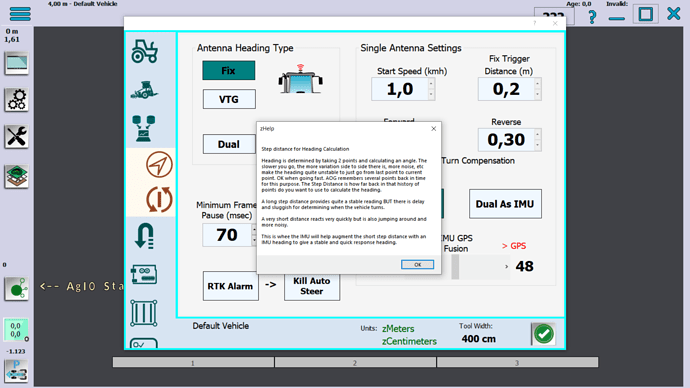So what is the difference between Fix to Fix and just taking heading out of VTG?
Is it just more for experimenting, or is it more stable than the VTG heading?
On a normal GPS i have found vtg heading to be much worse then fix to fix with min meter or so. especially going slower. When standing still vtg heading spins in circles.
There are exceptions for vtg like if an imu in a commercial unit corrects the heading, then vtg heading is just as good as a dual. Trimble does this, as well as JD
This is now more or less working in my proto code, I’ll keep you posted. Also includes the reverse detection by using the IMU accelerometer, only bug is picking up the correct direction the first time around. Hardware is Teensy 4.x + BNO08x and F9P receiver, basically similar setup as you have inside the €€€ commercial units for less than 300 €. On todo list to add the lat/lon fusion as well so you’d get good signal in case of sudden RTK drop out. Hope to spend more time on this starting next week as I have some time off from office work, it’s always the other things interfering ![]()
It’s just the bloody availability IMU chips that’s the problem now, and wouldn’t want to rely too much on only BNO080, should probably test some alternatives as well.
Yes, sorry thought it was fix to fix distance.
(Or is it the same?)
This one sounds pretty much on par with the BN0 and has a sparkfun board, but where to find a library?
ICM20948 IMU
sparkfun?
Sparkfun is a company makes breakout boards for electronic components for use in prototyping and education, much like adafruit, or ardusimple.
My profile pic is a Sparkfun F9P.
Yes, they have hookup files for their products.
You have the library on their official website, as well as the hookup guide.
Sounds interesting, need to give it a try.
GOOD Informations this !!! waiting !
I tried to install on several machines, but it’s never 100% good. more like 50%…
The best results are obtained when I increase the starting speed to 2 km/h. this poses other problems. I think the heading is not stable at low speed which leads to direction detection errors.
Maybe I’m going to say something stupid because I have no idea how it’s done in code. but earlier than based on fix to fix heading or imu/gps mix, couldn’t you trust the imu 100% for direction sensing. the steering angle (yaw) still looks good with the imu.
The latest fixes branch uses the imu for going super slow and backing up. It works a lot better.
I had the same problem, event went as far as studying the code. This gave me the impression reverse detection is mainly based on fix2fix heading (not the most reliable heading during turning). I will try v5Fixes. One related issue is the direction reset function. This function is helpful but can be very slow, it can take more than 5 seconds for the rotation to complete, where you need an instant reversal.
With 5 seconds ,you must have IMU GPS fusion set at almost 99 % IMU. Otherwise you have something else slowing down your setup. (what is your Frame Rate number when driving/turning)
60% IMU should do ![]()
True, more Fix wil speed up the reset, however, more IMU gives me better steering. IMU is set at 90%. Running at 10 HZ.
I tried the other way, and found more fix to fix was as good, setting IMU at 60% and raising trigger distance to somewhere between 0,5 and 1 meter
I used ? mark to get this info.
It will depend on the soil, type of vehicle, working speed etc. But in general, when comparing IMU and fix2fix heading during work, the first one is much more stable. Fix2fix tends to get jumpy with trigger distances < 1 meter. A high IMU setting helps me to get very calm and precise steering. It would be a waste to give this up because of the slow direction reset.

